Renault 5
| Renault 5 | |
|---|---|
 Second generation R5 GT Turbo | |
| Overview | |
| Manufacturer | Renault |
| Production | 1972–1996 |
| Body and chassis | |
| Class | Supermini (B) |
| Chronology | |
| Successor | Renault Clio |
The Renault 5 is a supermini produced by French automaker Renault. It was produced in two generations 1972–1985 (also called R5) and 1984–1996 (also called Super 5 or Supercinq). The R5 was sold in the US as Le Car, from 1976 to 1983. Nearly 5.5 million were built.[1]
The Renault 5 achieved, like the original Mini, a cult status.[2]
First generation (1972–1984)
| Renault 5 | |
|---|---|
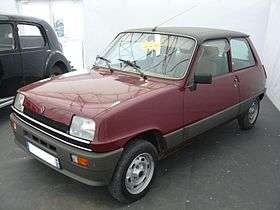 First generation, front | |
| Overview | |
| Also called | Renault Le Car (USA) |
| Production | 1972–1985 |
| Assembly |
|
| Designer | Michel Boué |
| Body and chassis | |
| Body style | 3/5-door hatchback |
| Layout | MF layout |
| Related |
Renault 4 Renault 7 Renault Rodeo |
| Powertrain | |
| Engine |
782 cc I4 Ventoux 845 cc I4 Ventoux 956 cc C1C I4 1108 cc C1E I4 1289 cc 810 I4 1397 cc C1J I4 1397 cc C6J turbo I4 |
| Transmission |
4/5-speed manual 3-speed automatic |
| Dimensions | |
| Wheelbase | 2,419 mm (95.2 in) |
| Length | 3,521 mm (138.6 in) |
| Width | 1,525 mm (60.0 in) |
| Height | 1,410 mm (55.5 in) |
| Kerb weight | 730–810 kg (1,610–1,790 lb) |
Images and details of the Renault 5 were published on 10 December 1971, the car's formal launch following on 28 January 1972.[5][6]
The Renault 5 was styled by Michel Boué,[7] who designed the car in his spare time, outside of his normal duties.[7] When Renault executives learned of Boué's work, they were so impressed by his concept they immediately authorized a formal development programme. The R5 featured a steeply sloping rear hatchback and front dashboard. Boué had wanted the tail-lights to go all the way up from the bumper into the C-pillar, in the fashion of the much later Fiat Punto and Volvo 850 estate / wagon, but the lights remained at a more conventional level. The 5 narrowly missed out on the 1973 European Car of the Year award, which was instead given to the Audi 80.
Boué died of cancer in 1971, just months before the car he designed was launched.
The R5 borrowed mechanicals from the similarly popular Renault 4, using a longitudinally-mounted engine driving the front wheels with torsion bar suspension. OHV engines were borrowed from the Renault 4 and larger Renault 8: there was a choice, at launch, between 782 cc and 956 cc according to price level. A "5TS/5LS" with the 1,289 cc engine from the Renault 12 was added from April 1974. As on the Renault 4, entry level Renault 5s had their engine sizes increased to 845 cc in 1976 and at the top of the range later models had the engine sizes expanded to 1,397 cc.
It was one of the first modern superminis, which capitalised on the new hatchback design, developed by Renault in the mid 1960s on its larger R16. It was launched a year after the booted version of the Fiat 127, and during the same year that the 127 became available with a hatchback. Within five years, a number of rival manufacturers - namely Ford, General Motors and Volkswagen - had launched a similar car.
Although the mechanical components came from earlier models, body construction involved floor sections welded together with the other body panels, resulting in a monocoque structure.[5] The approach had by then become mainstream among many European automakers, but represented an advance on the mechanically similar Renault 4 and Renault 6 both of which used a separate platform. The monocoque structure reduced the car's weight, but required investment in new production processes.
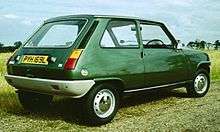
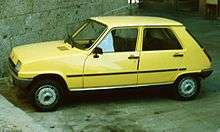
The Renault 5 was targeted at cost conscious customers, and the entry level "L" version came with the same 782 cc power plant as the cheaper Renault 4 and drum brakes on all four wheels. In 1972 it was priced in France at below 10,000 francs.[5] However, for many export markets the entry level version was excluded from the range and front wheel disc brakes were offered on the more powerful 956 cc "Renault 5TL" along with such attractions under the bonnet/hood and an alternator, and in the cabin reclining back rests for the front seats.[5] From outside the "TL" was differentiated from the "L" by a thin chrome strip below the doors.[5]
The early production R5 used a dashboard-mounted gearshift, linked by a rod which ran over the top of the engine to a single bend where the rod turned downwards and linked into the gearbox, which was positioned directly in front of the engine. A floor-mounted lever employing a cable linkage replaced this arrangement in 1973. An automatic version, with the larger 1,289 cc engine, was added in early 1978. At the time, the automatic usually represented just under five percent of overall Renault 5 production.[8] Door handles were formed by a cut-out in the door panel and B-pillar. The R5 was one of the first cars produced with plastic (polyester and glass fibre) bumpers, which came from a specialist Renault factory at Dreux.[5] These covered a larger area of potential contact than conventional car bumpers of the time and survived low speed parking shunts without permanently distorting.[5] This helped the car gain a reputation as an "outstanding city car",[5] and bumpers of this type subsequently became an industry standard.
The R5's engine was set well back in the engine bay, behind the gearbox, allowing the stowage of the spare wheel under the bonnet/hood, an arrangement that freed more space for passengers and luggage within the cabin.[9] The passenger compartment "is remarkably spacious" in comparison to other modern, small European cars.[10] The Renault 5 body's drag coefficient was only 0.37 (with most European cars going up to 0.45).[11]
Other versions of the first generation included the four-door saloon version called the Renault 7 and built by FASA-Renault of Spain, where virtually all examples were sold. A five-door R5 was added to the range in 1979, making it one of the first cars of its size to feature four passenger doors.[12] The three-speed Automatic, which received equipment similar to the R5 GTL but with a 1,289 cc (55 bhp) engine, a vinyl roof, and the TS' front seats, also became available with five-door bodywork. In March 1981 the automatic received a somewhat more powerful 1.4 litre engine, which paradoxically increased both performance and fuel economy at all speeds.[8]
Renault 5 Alpine/Gordini
The Renault 5 Alpine was one of the first hot-hatches, launched in 1976 - going on sale around the same time as the original Volkswagen Golf GTI. In the UK, the car was sold as the Renault 5 Gordini because Chrysler Europe already had the rights to the name "Alpine" in the UK and it had just been introduced on the Chrysler Alpine (UK version of Simca 1307) at the time. Use of the name Gordini was from Amédée Gordini, who was a French tuner with strong links with Renault and previous sporting models such as the Renault 8. This (and the later Alpine Turbo models) were assembled at Alpine's Dieppe plant, beginning in 1975.[3]
The 1.4 L (1397 cc) OHV engine, mated to a five-speed gearbox, was based on the Renault "Sierra" pushrod engine, but having a crossflow cylinder head with hemispherical combustion chambers and developed 93 PS (68 kW; 92 hp), twice as much as a standard 1.1 L (1108 cc) Renault 5. The larger engine and its various performance parts meant that the spare tire could no longer fit there and was relocated to the boot.[13] The Alpine could be identified by special alloy wheels and front fog lights and was equipped with stiffened suspension, but still retaining the torsion bar all round. The UK car magazine Motor road test figures quoted top speed of 104.7 mph (168.5 km/h) and 0-60 mph in 9.7 seconds.[14]
Renault 5 Alpine Turbo/Gordini Turbo
The Renault 5 Alpine Turbo was launched in 1982 as an upgraded successor to the naturally aspirated Alpine.[15] In Britain, the car was still called Gordini rather than Alpine. Motor magazine undertook a road test of the Turbo in 1982 and while they appreciated the performance (top speed 179.9 km/h (111.8 mph), 0 to 97 kilometres per hour (0 to 60 mph) in 8.7 seconds), they were critical of its high price as it was £2 more than the larger Ford Escort XR3.[16]
The 1.4 L (1,397 cc) was the same as the Alpine, but with the addition of a single Garrett T3 turbocharger increasing the power output to 110 bhp (82 kW; 112 PS).[17] Sales continued until 1984 when the second generation Renault 5 was launched, and the release of the Renault 5 GT Turbo in 1985.
.jpg)
Renault 5 Turbo
The Renault 5 Turbo should not be confused with the Alpine Turbo or GT Turbo as it was radically modified by mounting a turbocharged engine behind the driver in what is normally the passenger compartment, creating a mid-engined hot hatch and rally car. It was also driven by the rear wheels rather than the front wheels. The Renault 5 Turbo was made in many guises, eventually culminating with the Renault 5 Maxi Turbo.
Renault Le Car
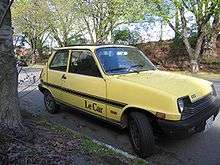
The North American Renault 5 debuted in 1976 as the Le Car. American Motors Corporation (AMC) marketed it through its 1300 dealers where it competed in the United States against such front-wheel-drive subcompacts as the Honda Civic and Volkswagen Rabbit. It was described as a "French Rabbit" that "is low on style, but high on personality and practicality".[18]
AMC's ad agency launched the car in the U.S. with a marketing campaign emphasizing that it was Europe's best selling automobile with millions of satisfied owners.[19] It did not achieve such immediate success in the United States market even though the Le Car was praised in road tests comparing "super-economy" cars for its interior room and smooth ride, with an economical [35 mpg-US (6.7 L/100 km; 42 mpg-imp) highway and 28 mpg-US (8.4 L/100 km; 34 mpg-imp) city] as well as smooth-running engine.[20]
The U.S. version featured a desmogged 1397 cc inline-four engine with a power of 55 hp (41 kW). In 1977 it dominated the Sports Car Club of America "Showroom Stock Class C" class.[21] Ever tightening emissions legislation meant that power was down to 51 hp (38 kW) by 1980.[22]
The Le Car was offered in three-door hatchback form only from 1976 until 1980. For the 1980 model year, the front end was updated to include a redesigned bumper and grille, as well as rectangular headlights. A five-door hatchback body style was added in the 1981 model year. Imports continued through 1983, when the car was replaced by the Kenosha, Wisconsin-built, Renault 11-based Renault Alliance. Sales in Canada continued until 1985, when production of the first generation Renault 5 came to an end.
In at least one U.S. municipality, the Le Car was used as a law enforcement vehicle, when the La Conner, Washington police department acquired three of the vehicles for its fleet in the late-1970s. Renault advertised Le Car's versatility in a full page ad featuring its use by the department.[23]
Chronology
- January 1972: Introduction of the Renault 5 in L and TL forms. Both models (which were available as three-door hatchbacks) had a folding rear seat, grey bumpers, wind up front windows, and a dashboard-mounted gear shift lever. The TL was better equipped, and had a vanity mirror for the front seat passenger, three ashtrays (one under the gear shift and two in the rear), two separate reclining front seats instead of one bench seat, front pull handles, and three stowage pockets as well as a heated rear window.
- September 1972: The Renault 5 was launched on the British market in right-hand drive form.
- 1973: Gear lever moved from dashboard to floor, between front seats.
- April 1974: Introduction of the R5 LS, same as the R5 TL, but with different wheels, H4 iodine headlights, electric windscreen washers, fully carpeted floor ahead of the front seats, carpeted rear parcel shelf, electronic rev counter, daily totalizer, two-speed ventilation system, and illuminated ashtray with cigarette lighter.
- September 1974: R5 LS renamed R5 TS.[24] The TS had all features of the previous LS, plus new front seats with integrated head restraints, black bumpers, illuminated heater panel, front spoiler, rear wiper, clock, opening rear quarter lights and reversing lights.
- February 1976: Introduction of the R5 Alpine, with 1,397 cc engine with hemispherical combustion chambers, high compression ratio and special five-speed manual gearbox. The R5 GTL was also launched in 1976 with the 1,289 cc engine from the R5 TS (with the power reduced to 42 bhp), the equipment specification of the R5 TL plus grey side protection strips and some features from the R5 TS such as the styled wheel rims, reversing lights, cigarette lighter, illuminated heater panel, and electric windscreen washers.
- 1977: The R5 GTL got opening rear quarter lights and the R5 L got the new 845 cc engine.
- January 1978: Introduction of the R5 Automatic, essentially a GTL with a three-speed automatic transmission and some features from the TS.
- August 1979: Five-door model presented[24]
- 1980: Five-door TL, GTL and Automatic models arrive
- 1982: Introduction of the R5 TX and the hot hatch R5 Alpine Turbo, a replacement for the R5 Alpine with a Garrett T3 turbo, new alloy wheels, stiffer suspension and disc brakes all-round.
- 1984: The R5 is replaced by a new, second generation, model
Engines
- B1B 0.8 L (845 cc or 51.6 cu in) 8-valve I4; 37 PS (27 kW; 36 hp); top speed: 126 km/h (78 mph); 0–100 km/h (62 mph): 22.3 s[25]
- C1C (689) 1.0 L (956 cc or 58.3 cu in) 8-valve I4; 42 PS (31 kW; 41 hp); top speed: 130 km/h (81 mph)
also with 44 PS (32 kW; 43 hp); top speed: 135 km/h (84 mph)[26]
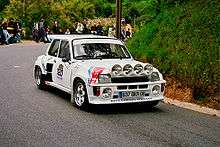
- C1E (688) 1.1 L (1,108 cc or 67.6 cu in) 8-valve I4; 45 PS (33 kW; 44 hp); top speed: 136 km/h (85 mph); 0–100 km/h (62 mph): 21.4 s[25]
- 810 1.3 L (1,289 cc or 78.7 cu in) 8-valve I4; 55 PS (40 kW; 54 hp); top speed: 140 km/h (87 mph) (automatic)
- 810 1.3 L (1,289 cc or 78.7 cu in) 8-valve I4; 64 PS (47 kW; 63 hp); top speed: 154 km/h (96 mph); 0–100 km/h (62 mph): 15.6 s[25]
- C1J (847) 1.4 L (1,397 cc or 85.3 cu in) 8-valve I4; 63 PS (46 kW; 62 hp); top speed: 142 km/h (88 mph); 0–100 km/h (62 mph): 21.4 s (automatic)[25]
- C6J 1.4 L (1,397 cc or 85.3 cu in) turbo 8-valve I4; 110 PS (81 kW; 108 hp); top speed: 185 km/h (115 mph); 0–100 km/h (62 mph): 9.1 s[25]
Motorsport
The Renault 5 Alpine version was raced in Group 2. In the 1978 Monte Carlo, the Renault 5 Alpine came second and third overall, despite a powerful team entry from Fiat and Lancia.[27]
For 1978, a rally Group 4 (later Group B) version was introduced. It was named as the Renault 5 Turbo, but being mid-engined and rear wheel drive, this car bore little technical resemblance to the road-going version. Though retaining the shape and general look of the 5, only the door panels were shared with the standard version. Driven by Jean Ragnotti, this car won the 1981 Monte Carlo Rally for its first race. The 2WD R5 turbo soon had to face the competition of new 4WD cars that proved to be faster on dirt; however, it remained among the fastest of its era on tarmac.
Production elsewhere
- Iran
The original Renault 5 continued to be produced in Iran by SAIPA, then by Pars Khodro (a SAIPA subsidiary), as the Sepand. In 2002, the Sepand's Renault 5 platform was replaced with that of a Kia Pride, while a modified version of the Renault 5's bodywork was kept.
- South Africa
Assembly in South Africa began in late 1975, in Durban. The car was built in Toyota's local plant and sold through their network.[28] The 5 was only available with one engine, the 1.3-liter unit used in the European R5 TS. Claimed output is 49.29 kW (67.0 PS; 66.1 hp) SAE.[28] There was a base model, with vinyl seats and lap belts only, and the upmarket LS and LSS models. These received fabric interior, side stripes, a vinyl roof, and more sound deadening and other comfort details. The LSS also got a central console and a full length fabric sunroof. Many extras used in Europe, such as a rear window wiper and a tachometer, were not available in South Africa because it would make it impossible to meet local content regulations. Local content was 56% at introduction; this was to be increased steadily as production wore on.[28]
By 1979 the lineup was restriceted to the GTL and the TS, both still with the 1289 cc engine but now with 34 or 46 kW (46 or 63 PS; 46 or 62 hp) ISO respectively.[13]
Second generation (1984–1996)
| Renault 5 "Supercinq" | |
|---|---|
 Second generation R5, 3-doors | |
| Overview | |
| Production | 1984–1996 |
| Assembly |
|
| Designer | Marcello Gandini |
| Body and chassis | |
| Body style |
3-door hatchback 5-door hatchback |
| Layout | FF layout |
| Related | Renault Rodeo |
| Powertrain | |
| Engine |
1.0 L C-Type I4 1.1 L C-Type I4 1.4 L C-Type I4 1.4 L C-Type I4 Turbo 1.7 L F-Type I4 1.6 L F-Type I4 Diesel |
| Transmission |
3-speed automatic 4-speed manual 5-speed manual |
| Dimensions | |
| Wheelbase |
2,407 mm (94.8 in) (3-door) 2,467 mm (97.1 in) (5-door) |
| Length |
3,591 mm (141.4 in) (3-door) 3,651 mm (143.7 in) (5-door) |
| Width | 1,584 mm (62.4 in) |
| Height |
1,387 mm (54.6 in) (3-door) 1,397 mm (55.0 in) (5-door) |
| Kerb weight | 695–840 kg (1,532–1,852 lb) |
The second generation Renault 5, often referred to as the Supercinq (or "Superfive"), appeared in the autumn of 1984 (RHD models from early 1985). Its launch came within 18 months of Ford, General Motors, Peugeot, Fiat and Nissan all launching new competitors in the supermini sector.
Although the bodyshell and chassis were completely new (the platform was based on that of the larger Renault 9 and 11), familiar 5 styling trademarks were retained; styling was the work of Marcello Gandini. The new body was wider and longer featuring 20 percent more glass area and more interior space, with a lower drag coefficient (0.35), as well as 57.4 mpg-US (4.10 L/100 km; 68.9 mpg-imp) at 90 kilometres per hour (56 mph) in the economy models.[29] The biggest change was the adoption of a transversely-mounted powertrain taken directly from the 9 and 11, plus a less sophisticated suspension design, which used MacPherson struts.
When launched, it had the following ranges: TC, TL, GTL, Automatic forms. The entry-level TC had the 956 cc engine (rated at 42 bhp), while the TL had the 1108 cc engine (rated at 47 bhp), and the GTL, Automatic, TS and TSE had the 1397 cc engine (rated at 60 PS (44 kW; 59 hp) for the GTL, 68 PS (50 kW; 67 hp) for the Automatic, and 72 PS (53 kW; 71 hp) for the TS and TSE). The TC and TL had a four-speed manual gearbox, while the GTL, TS and TSE had a five-speed manual gearbox (which was optional on the TL), and the Automatic had a three-speed automatic gearbox. 1987 saw the introduction of the 1721 cc F2N engine in the GTX, GTE (F3N) and Baccara (Monaco in some markets, notably the United Kingdom).
Renault decided to use the naturally aspirated 1.7 L from the Renault 9/11, which utilized multipoint fuel injection, in addition to the sports orientated 1.4 L turbo. Under the name GTE, it produced 95 PS (70 kW; 94 hp). Although not as fast as the turbo model, it featured the same interior and exterior appearance, as well as identical suspension and brakes. The Baccara and GTX versions also used the 1.7 engine - the former sporting a full leather interior, power steering, electric windows, sunroof, high specification audio equipment and as extras air-conditioning and On-Board Computer. The latter was effectively the same but the leather interior was an option and there were other detail changes. As with the previous generation, the 5 Turbo was again assembled at the Alpine plant in Dieppe, where forty cars per day were constructed in 1985.[3]
The model was starting to show its age by 1990, when it was effectively replaced by the Clio, which was a sales success across Europe. Production of the R5 was transferred to the Revoz factory in Slovenia when the Clio was launched. It remained on sale with only 1.1 L, 1.4 L petrol and 1.6 L naturally aspirated diesel engines,[30] as a minimally equipped budget choice called the Campus. until the car's production run finally came to an end in 1996. The R5 GT Turbo was discontinued in 1991, when the 16-valve Clio was launched.
The Campus sold more strongly in the United Kingdom than elsewhere, because the Renault Twingo that addressed the same market, was only sold in LHD form and only in mainland Europe.[30] In 2011, it was recommended as one of Britain's Best Bangers, by Car Mechanics Magazine because of the number of cheap, low mileage, full service history, examples available.[30] The Campus name was revived in 2005 with the Renault Clio II.
Renault 5 GT Turbo
A "hot hatch" version, the GT Turbo, was introduced in 1985. It used a modified four cylinder, eight-valve Cléon 1,397 cc engine, a pushrod unit dating back to the 1962 original (in 1,108 cc form). It was turbocharged with an air-cooled Garrett T2 turbocharger. Weighing a mere 850 kg (1,874 lb), and producing 115 PS (85 kW; 113 hp), the GT Turbo had an excellent power-to-weight ratio, permitting it to accelerate from a standstill to 60 mph (97 km/h) in 7.5 seconds.[31] To differentiate it from the standard 5, it came with blocky plastic side skirts. Unfortunately, turbo lag was an issue, along with poor hot starting, and was considered rather difficult to control. The same engine was used, with similar issues, in the Renault 9 and 11 Turbos.
In 1987, the facelifted Phase II was launched.[32] Major changes in the Phase II version included installing watercooling to the turbocharger, aiding the Phase I's oil-cooled setup, which extended the life of the turbo. It also received a new ignition system which permitted it to rev 500 rpm higher. These changes boosted engine output up to over 120 PS (88 kW; 118 hp). Externally, the car was revamped, with changes (including new bumpers and arches) that reduced the car's drag coefficient from 0.36 to 0.35. Giving the Phase II a 0–100 km/h time of 7.5 secs.[33] In 1989 the GT Turbo received a new interior, and in 1990 the special edition Raider model (available only in metallic blue, with different interior and wheels) was launched. In late 1991 the Renault 5 GT Turbo was discontinued, superseded by the Clio 16v and the Clio Williams.
The Renault 5 GT Turbo's 1989 victory in the 1989 Rallye Côte d'Ivoire remains the only overall WRC victory for a Group N car.
- WRC victories
| No. | Event | Season | Driver | Co-driver | Car |
|---|---|---|---|---|---|
| 1 | |
1989 | |
|
Renault 5 GT Turbo |
 Renault 5 GT Turbo Raider
Renault 5 GT Turbo Raider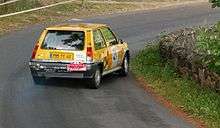 Renault 5 GT Turbo in the 2010 Rallye Velay Auvergne (Group N)
Renault 5 GT Turbo in the 2010 Rallye Velay Auvergne (Group N)
Roger Saunders and Alex Postan both took part in the 1987 British Touring Car Championship season using a 5 GT Turbo.
Renault Express

The second-generation R5 also spawned a panel van version, known as the Renault Express. It was commercialized in some European countries as the Renault Extra (UK and Ireland) or Renault Rapid (mainly German speaking countries). This car was intended to replace the R4 F6 panel van, production of which had ceased in 1986. From 1996 to 2002 the Express was produced for South America at Nordex in Uruguay.
EBS convertible
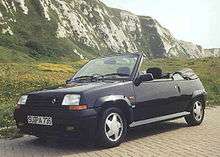
In 1989, the Belgian company EBS produced convertible versions of the Renault 5 (1,400 in total), almost all of which were left-hand drive.[34] A total of 14 of the 1,400 cars produced were based on the right-hand drive GT Turbo Phase II.
Engines
- C1C (689) 1.0 L (956 cc or 58.3 cu in) 8-valve I4; 42 PS (31 kW; 41 hp); top speed: 130 km/h (81 mph)
- C1E 1.1 L (1,108 cc or 67.6 cu in) 8-valve I4; 49 PS (36 kW; 48 hp); top speed: 150 km/h (93 mph)
- C1J (847) 1.4 L (1,397 cc or 85.3 cu in) 8-valve I4; 63 to 68 PS (46 to 50 kW; 62 to 67 hp); top speed: 155 km/h (96 mph)
- C1J (784-788) 1.4 L (1,397 cc or 85.3 cu in) turbo 8-valve I4; 115 to 120 PS (85 to 88 kW; 113 to 118 hp); top speed: 204 km/h (127 mph); 0–100 km/h (62 mph): 7.9–7.5 seconds
- F2N 1.7 L (1,721 cc or 105.0 cu in) 8-valve I4; 82 PS (60 kW; 81 hp); top speed: 170 km/h (106 mph); 0–100 km/h (62 mph): 8.9 seconds
Production
Overall production of R5 is: 5,580,626 units, including:
- Renault 5 French (1972-1985): 5,276,630
- Iranian R5 (1987-1992): 49,270
- R5 Turbo (1980 to 1986): 4987
- R5 Maxi (1975 to 1986): 154
- R5 society (1975-1984): 218,795
- Siete (Spanish R5 4-door) (1974-1982): 30,790
- Supercinq (1984 - 1996) 3,436,650
References
- ↑ Pleffer, Ashlee (10 March 2008). "Renault 5: it's french for good". The Daily Telegraph. Australia. Retrieved 26 May 2014.
- ↑ Sparrow, David (1992). Renault 5: Le Car. Osprey Publishing. ISBN 978-1-85532-230-1.
- 1 2 3 Barbaza, Pierre (April 1985). "L'usine Alpine: renaissance ou révolution?" [The Alpine works: renaissance or revolution?]. Echappement (in French). Paris, France: Michael Hommell (198): 90.
- ↑ Thevenet, Jean-Paul, ed. (January 1977). "30 jours d'automobile" [30 days of the automobile]. L'Automobile (in French). Neuilly, France: Societé des Editions Techniques et Touristiques de France (367): 4.
- 1 2 3 4 5 6 7 8 Bellu, René (2005). "Toutes les voitures françaises 1972 (salon [Oct] 1971)". Automobilia. Paris: Histoire & collections. 76s: 50–53.
- ↑ "Morors: Renault's New Baby". Evening News. 10 December 1971. p. 35. Retrieved 26 May 2014.
- 1 2 Ludvigsen, Karl (March 2010). "The Renault That Rumbled". Hemmings Sports & Exotic Car. Retrieved 15 June 2011.
- 1 2 Costa, André & Georges-Michel Fraichard, ed. (September 1981). "Salon 1981: Toutes les Voitures du Monde". l'Auto Journal (in French). Paris (14 & 15): 65.
- ↑ "Motor Show Review 1973 Cars (Renault 5)". Daily Mail. London. October 1972. p. 41.
- ↑ Horbue, Jan P. (February 1975). "The new logic in small-car engineering". Popular Science. 206 (2): 56–59. Retrieved 15 June 2011.
- ↑ Genta, Giancarlo; Morello, Lorenzo (2009). The Automotive Chassis: System design. Springer. p. 142. ISBN 978-1-4020-8673-1. Retrieved 15 June 2011.
- ↑ "Renault 5". Classic and Performance Car. Retrieved 22 August 2012.
- 1 2 Howard, Tony (June 1979). "London Review". SA Auto. Pretoria, South Africa. 1 (10): 14.
- ↑ Motor 5 May 1979
- ↑ The Glasgow Herald, May 31, 1982
- ↑ Motor Road Test Annual 1982
- ↑ "Octane - Model specs: 1976-1984 Renault 5 Gordini/Turbo". Classic Car and Performance Car. Retrieved 15 June 2011.
- ↑ Witzenburg, Gary (February 1982). "Imports '82". Popular Mechanics. 155 (2): 120. Retrieved 15 June 2011.
- ↑ Advertising techniques. ADA Publishing. 1979. pp. 26–28. ISSN 0001-0235.
- ↑ Dunne, Jim; Hill, Ray (November 1976). "Super-economy Cars". Popular Science. 209 (5): 38–46. Retrieved 15 June 2011.
- ↑ SportsCar Magazine by the Sports Car Club of America, 1977.
- ↑ Hogg, Tony (ed.). "1981 Buyer's Guide". Road & Track's Road Test Annual & Buyer's Guide 1981 (January–February 1981): 113.
- ↑ Jewell, Alden. "1978 Renault Le Police Car". Flickr. Retrieved 2011-06-15.
- 1 2 Salon 1981, p. 115
- 1 2 3 4 5 Freund, Klaus, ed. (August 1981). Auto Katalog 1982 (in German). 25. Stuttgart: Motor Presse. pp. 220–221.
- ↑ World Cars 1982. Herald Books. 1982. p. 90. ISBN 9780910714143.
- ↑ Observer-Reporter January 28, 1978
- 1 2 3 Howard, Tony (December 1975). "Très chic, but économe". SA Motor. Cape Town, South Africa: Scott Publications: 32.
- ↑ "Euro hatchback". Popular Science. 206 (1): 36. January 1985. Retrieved 15 June 2011.
- 1 2 3 Car Mechanics Magazine - January 2011 P.42-3
- ↑ "Renault 5 GT Turbo". Evo. November 2008. Retrieved 1 February 2012.
- ↑ Porter, Richard (November 2008). "Renault 5 GT Turbo". Evo. Retrieved 15 June 2011.
- ↑ "Technical Specifications (Renault literature)". renault5gtturbo.com. Retrieved 26 May 2014.
- ↑ "EBS Renault 5 Convertible". Renault 5 Wiki. Retrieved 15 June 2011.
- Covello, Mike; Flammang, James M. (2002). Standard Catalog of Imported Cars 1946-2002. Krause Publications. ISBN 978-0-87341-605-4.
External links
| Wikimedia Commons has media related to Renault 5. |
- "Road Test - Renault 5 GT Turbo" Autocar (UK) magazine, 26 March 1986
- Renault 5 details (French)/(English)/(Spanish)
- First-generation Renault 5s
- RenaultSportClub - Anything from R5 Alpine to R.S. Clio 220T Trophy
| « previous — Renault car timeline, 1940s–1980s — next » | |||||||||||||||||||||||||||||||||||||||||||||
|---|---|---|---|---|---|---|---|---|---|---|---|---|---|---|---|---|---|---|---|---|---|---|---|---|---|---|---|---|---|---|---|---|---|---|---|---|---|---|---|---|---|---|---|---|---|
| Type | 1940s | 1950s | 1960s | 1970s | 1980s | ||||||||||||||||||||||||||||||||||||||||
| 5 | 6 | 7 | 8 | 9 | 0 | 1 | 2 | 3 | 4 | 5 | 6 | 7 | 8 | 9 | 0 | 1 | 2 | 3 | 4 | 5 | 6 | 7 | 8 | 9 | 0 | 1 | 2 | 3 | 4 | 5 | 6 | 7 | 8 | 9 | 0 | 1 | 2 | 3 | 4 | 5 | 6 | 7 | 8 | 9 | |
| Economy car | 3 / 4 | 4 | |||||||||||||||||||||||||||||||||||||||||||
| Supermini | 5 / 7 | 5 | |||||||||||||||||||||||||||||||||||||||||||
| Small family car | Juvaquatre | Dauphine | 6 | 14 | 9 / 11 | 19 | |||||||||||||||||||||||||||||||||||||||
| 4CV | 8 / 10 | ||||||||||||||||||||||||||||||||||||||||||||
| Large family car | Colorale | 12 | 18 | 21 | |||||||||||||||||||||||||||||||||||||||||
| Executive car | Frégate | 16 | 20 / 30 | 25 | |||||||||||||||||||||||||||||||||||||||||
| Coupé | 15 / 17 | Fuego | |||||||||||||||||||||||||||||||||||||||||||
| Torino | |||||||||||||||||||||||||||||||||||||||||||||
| Roadster | Caravelle | ||||||||||||||||||||||||||||||||||||||||||||
| Sports car | Alpine A610 | ||||||||||||||||||||||||||||||||||||||||||||
| Large MPV | Espace | ||||||||||||||||||||||||||||||||||||||||||||
| Off-roader | Rodeo 4 / 6 | Rodeo | |||||||||||||||||||||||||||||||||||||||||||
| Van | Estafette | Trafic | |||||||||||||||||||||||||||||||||||||||||||
| Master | |||||||||||||||||||||||||||||||||||||||||||||
| « previous — Renault vehicles timeline 1980 to date, Western European and North American market | ||||||||||||||||||||||||||||||||||||||||||||
|---|---|---|---|---|---|---|---|---|---|---|---|---|---|---|---|---|---|---|---|---|---|---|---|---|---|---|---|---|---|---|---|---|---|---|---|---|---|---|---|---|---|---|---|---|
| Type | 1980s | 1990s | 2000s | 2010s | ||||||||||||||||||||||||||||||||||||||||
| 0 | 1 | 2 | 3 | 4 | 5 | 6 | 7 | 8 | 9 | 0 | 1 | 2 | 3 | 4 | 5 | 6 | 7 | 8 | 9 | 0 | 1 | 2 | 3 | 4 | 5 | 6 | 7 | 8 | 9 | 0 | 1 | 2 | 3 | 4 | 5 | 6 | ||||||||
| City car | 4 | Twingo I | Twingo II | Twingo III | ||||||||||||||||||||||||||||||||||||||||
| Twizy | ||||||||||||||||||||||||||||||||||||||||||||
| Supermini | 5 / 7 | Super 5 | Clio Symbol | Symbol II | ||||||||||||||||||||||||||||||||||||||||
| Clio I | Clio II | Clio III | Clio IV | |||||||||||||||||||||||||||||||||||||||||
| Zoe | ||||||||||||||||||||||||||||||||||||||||||||
| Small family car | 14 | 9 / 11 | 19 | Fluence | ||||||||||||||||||||||||||||||||||||||||
| Alliance / Encore | Mégane I | Mégane II | Mégane III | Mégane IV | ||||||||||||||||||||||||||||||||||||||||
| Large family car | 18 | 21 / Medallion | Laguna I | Laguna II | Laguna III | Talisman | ||||||||||||||||||||||||||||||||||||||
| Executive car | 20 / 30 | 25 | Safrane | Vel Satis | Latitude | |||||||||||||||||||||||||||||||||||||||
| Coupé | Fuego | Avantime | Laguna Coupé | |||||||||||||||||||||||||||||||||||||||||
| Roadster | Spider | Wind | ||||||||||||||||||||||||||||||||||||||||||
| Crossover SUV | Captur | |||||||||||||||||||||||||||||||||||||||||||
| Koleos | ||||||||||||||||||||||||||||||||||||||||||||
| Kadjar | ||||||||||||||||||||||||||||||||||||||||||||
| Mini MPV | Modus | |||||||||||||||||||||||||||||||||||||||||||
| Compact MPV | Scénic I | Scénic II | Scénic III | |||||||||||||||||||||||||||||||||||||||||
| Large MPV/CUV | Espace I | Espace II | Espace III | Espace IV | Espace V | |||||||||||||||||||||||||||||||||||||||
| LAV | Express | Kangoo I | Kangoo II | |||||||||||||||||||||||||||||||||||||||||
| Van | Trafic I | Trafic II | Trafic III | |||||||||||||||||||||||||||||||||||||||||
| Master I | Master II | Master III | ||||||||||||||||||||||||||||||||||||||||||
| American Motors (AMC) road car timeline, United States market, 1954–1987 Eagle » | |||||||||||||||||||||||||||||||||||
|---|---|---|---|---|---|---|---|---|---|---|---|---|---|---|---|---|---|---|---|---|---|---|---|---|---|---|---|---|---|---|---|---|---|---|---|
| Type | 1950s | 1960s | 1970s | 1980s | |||||||||||||||||||||||||||||||
| 4 | 5 | 6 | 7 | 8 | 9 | 0 | 1 | 2 | 3 | 4 | 5 | 6 | 7 | 8 | 9 | 0 | 1 | 2 | 3 | 4 | 5 | 6 | 7 | 8 | 9 | 0 | 1 | 2 | 3 | 4 | 5 | 6 | 7 | ||
| Subcompact car | Metropolitan | LeCar | Encore | ||||||||||||||||||||||||||||||||
| Gremlin | Spirit | ||||||||||||||||||||||||||||||||||
| Compact car | Rambler | Rambler American | Hornet | Concord | |||||||||||||||||||||||||||||||
| Jet | Pacer | Alliance | |||||||||||||||||||||||||||||||||
| Mid-size car | Six and V8 | Six | Classic | Rebel | Matador | 18i/Sportwagon | Medallion | ||||||||||||||||||||||||||||
| Rebel | Marlin | Matador Coupe | |||||||||||||||||||||||||||||||||
| Full-size car | Nash Ambassador | Ambassador | |||||||||||||||||||||||||||||||||
| Hudson Hornet | |||||||||||||||||||||||||||||||||||
| Hudson Wasp | |||||||||||||||||||||||||||||||||||
| Sports car/Roadster | N-H | AMX | AMX | Fuego | GTA | ||||||||||||||||||||||||||||||
| Italia | Javelin | ||||||||||||||||||||||||||||||||||
| Crossover utility vehicle | Eagle | ||||||||||||||||||||||||||||||||||
| SUV | see early timeline of Jeep models | see late timeline of Jeep models | |||||||||||||||||||||||||||||||||
| Military vehicles | Mighty Mite | AM General | |||||||||||||||||||||||||||||||||
| Vehicle sold under Renault marque | |||||||||||||||||||||||||||||||||||